My first photo exhibition is now up in Anchorage, AK. Most of my readers won’t be able to make it so I’m putting part of the show online here at Bohemian Traveler.
I wanted to tell the story of Myanmar through these images and accompanying text based on my experiences traveling there last year with documentary photographer Dustin Main, who now leads his own small group trips to Myanmar. If these photos pique your interest, check out the details of the next trip: Un-tour to Myanmar in November 2018.
The photos are taken in Yangon, Inle Lake, Bagan, and around Kalaw in Shan State. Let me know in the comments which is your favorite. Details on the exhibit are at the end of the post.
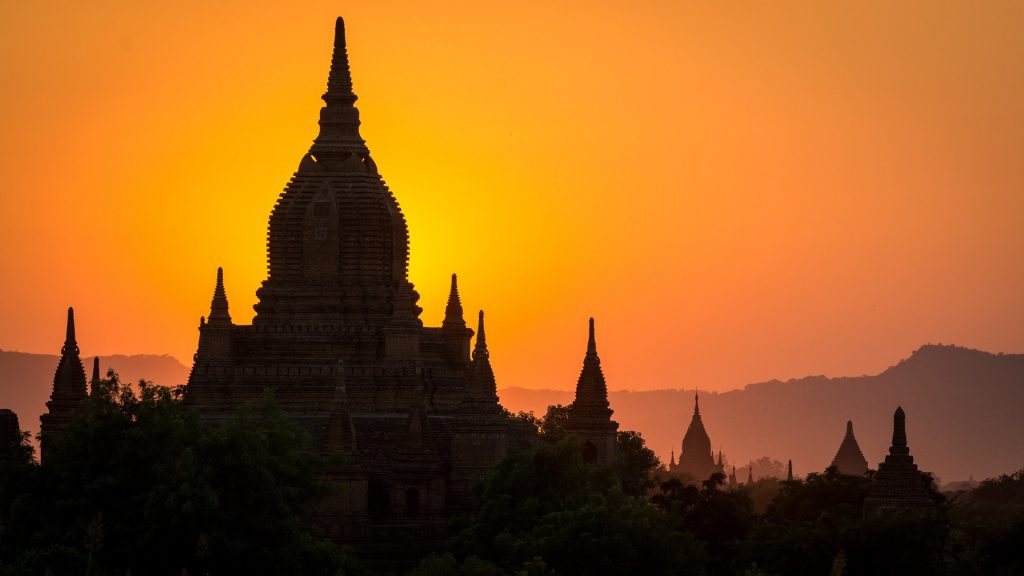
Journey to the Golden Land: The People and Places of Myanmar
Long closed off to the outside world, the land formerly known as Burma, is now open to travelers. Those who take the time to visit will be rewarded with endless golden stupas, delicious food, unforgettable sunrises, and meet some of the world’s friendliest people.
In 1898 Rudyard Kipling said: “This is Burma and it is unlike any land you know about.”
To a large extent, the same could still be said today. Neighboring giants India and China have influenced and shaped Myanmar over the centuries. Today, 135 distinct ethnic groups make up the country, with speakers of numerous different languages. The name Myanmar is actually more inclusive than the old name, Burma, which just represented the majority Burmese.
Visiting the country introduces the traveler to these various cultures. Despite its northern and western influences through history, Myanmar certainly feels like it’s part of southeast Asia. One can identify many similarities with Thailand. But from all of this, we can draw that Myanmar is wholly unique.

In most place, you ride a train to get from point A to point B quickly and efficiently. In Myanmar, the trains work in neither of these ways. And that’s precisely why we should ride the rails. Trains here are a slow, rickety affair. Maybe a little dusty, and always interesting. Whether you are riding the circle line around Yangon or the link between Kalaw and Inle Lake, you will get a better appreciation of life in Myanmar. You’ll linger at stations while bare-chested men haul sacks of grain and vegetables on and off, you’ll be approached by women selling ready-to-eat food, you’ll be greeted by someone who’s curious about where you’ve come from. And best of all, you’ll lean back in your seat after pulling out of the station and just enjoy the view outside your window.

Each morning, if the weather is calm, dozens of hot air balloon float over Bagan Archeological Park. The peaceful nature of this quiet transport, along with the colors of the dawn sky create an unforgettable scene. Find yourself one of the 2,200 pagodas and climb to the top to take it all in.
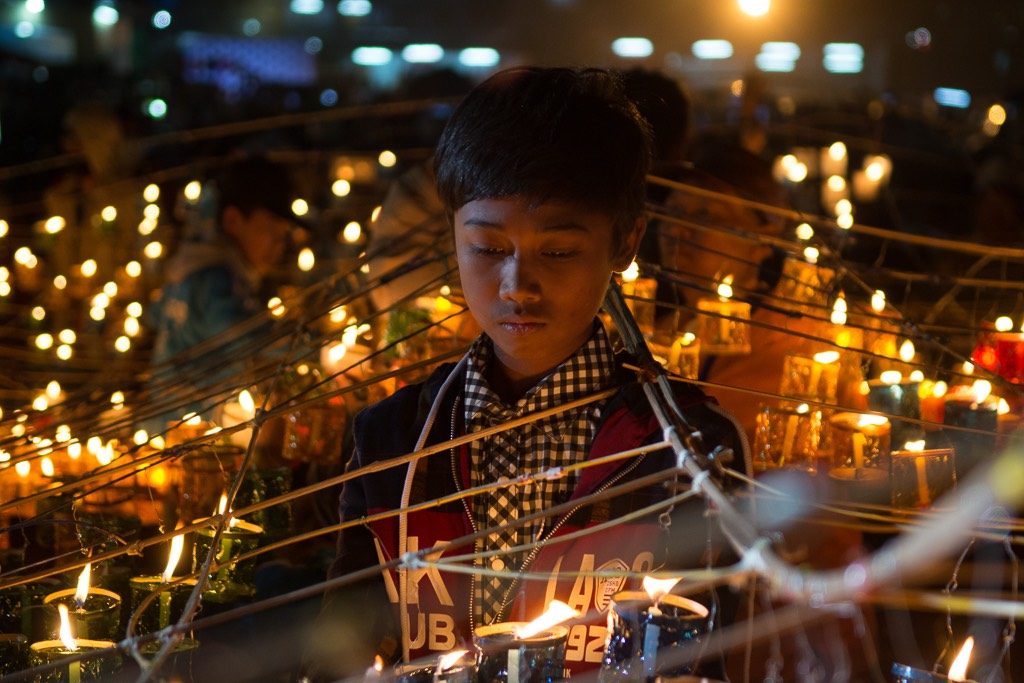
The Tazaungdaing Lights Festival is a yearly event which usually takes place in October or November leading up to the full moon in the month of Tazaungmon on the lunar calendar. It helps celebrate the end of the rainy season as it transitions to the cooler and drier months that will follow. Here, a boy lights candles before the launch of the towering fire balloon into the night sky.

The Great Railway Bazaar: By Train Through Asia, a travelogue by the American novelist Paul Theroux, is now considered a classic of the genre. It reminds us that the railways in this part of the world are like an everlasting market. As soon as the train stops, vendors come aboard, or riders disembark looking for some kind of snack or local treat. In this case, the transaction happens through an open window. As a traveler, riding the train opens us up to local life and exposes us to the micro-economy of a place.

The Inle Lake region is one of Myanmar’s most visited, and few leave disappointed. It’s a vast lake, 13.5 miles long and 7 miles wide, fringed by marshes and floating gardens, with stilt-house villages and Buddhist temples rising above the water. Most unique may be the Intha fisherman who show off there special technique of leg-rowing and catching fish with big bamboo nets.
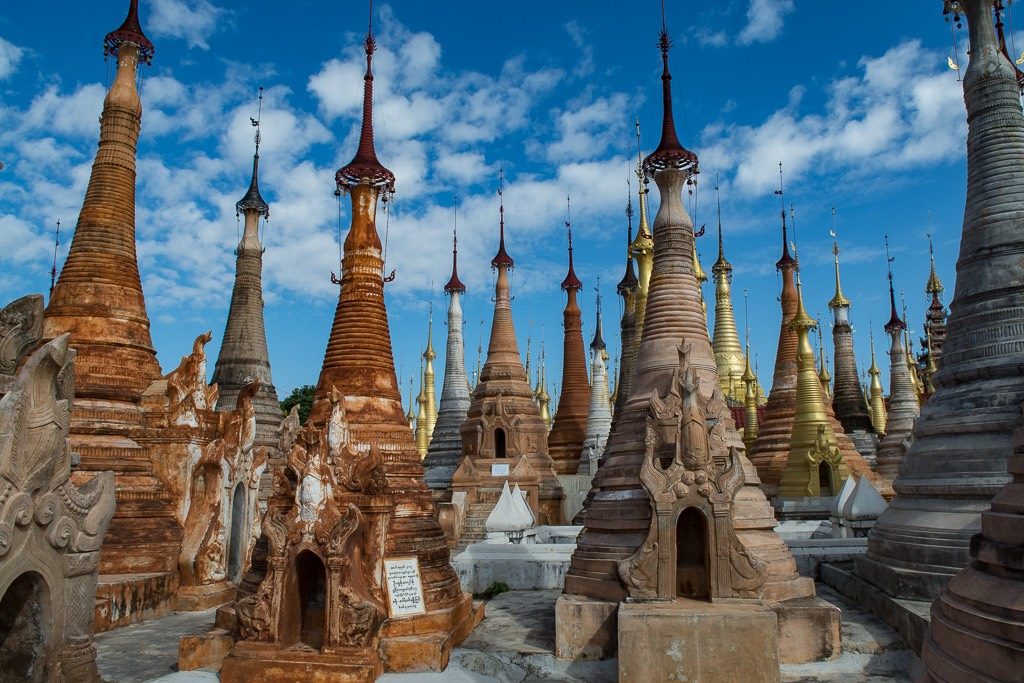
Shwe Indein Pagoda Complex is a group of Buddhist pagodas in the village of Indein, near Ywama and Inlay Lake in Shan State, Myanmar. With 1,054 pagodas in the shape of a bodhi leaves it has earned the nickname “Little Bagan”. The first is thought to date from 100 BC when its founder came from India. Today, the faithful make pilgrimages here as well as tourists. Visitors ride the scenic 5-mile boat ride across Inle Lake before wandering up the long staircase lined with souvenir vendors. Smart travelers go early in the morning before the crowds arrive.

In Myanmar, it’s customary for every young boy to enter a Buddhist monastery at least once. Becoming a novice monk is a great honor for families. Most boys become novices between the ages of five and 15, don crimson robes, and remain at the monastery for at least a week, although many stay longer. Once they reach adulthood, boys can decide whether they want to become fully ordained monks. This boy was serving at a small monastery on a hillside overlooking Inle Lake.
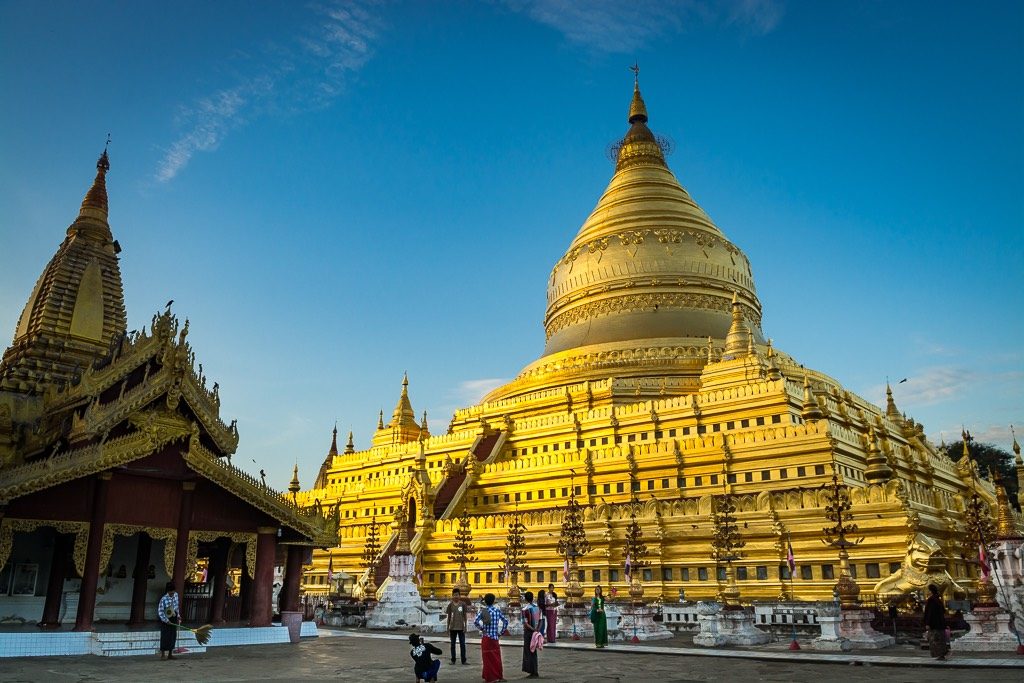
In 1044, the King of Bagan accepted Buddhism for his country. Before that, the people were Hindu, and also practiced Spiritualism and Animism. Construction of the Shwezigon Pagoda was completed in 1102 AD. Over the centuries it has been damaged by many earthquakes and other natural calamities but has always been renovated with care. Worshippers still flock here, especially first thing in the morning when then low sun casts its rays on the golden stupa.

The train is two hours late. In most places, we would have grown impatient and irritable. But in Myanmar, we just roll with it. I am waiting with my travel companions at a small village rail station in Shan State. We are looking for a ride back to Kalaw. In the meantime, we have eaten a relaxed lunch and drank a coconut and now I’m wandering around to kill more time. I meet this girl at her Auntie’s cafe before she heads out to sell her wares to the train passengers. She wears thanaka on her face. It is a yellowish-white cosmetic paste made from ground bark and a distinctive feature of the culture of Myanmar. People here have applied it to their faces for over 2,000 years.
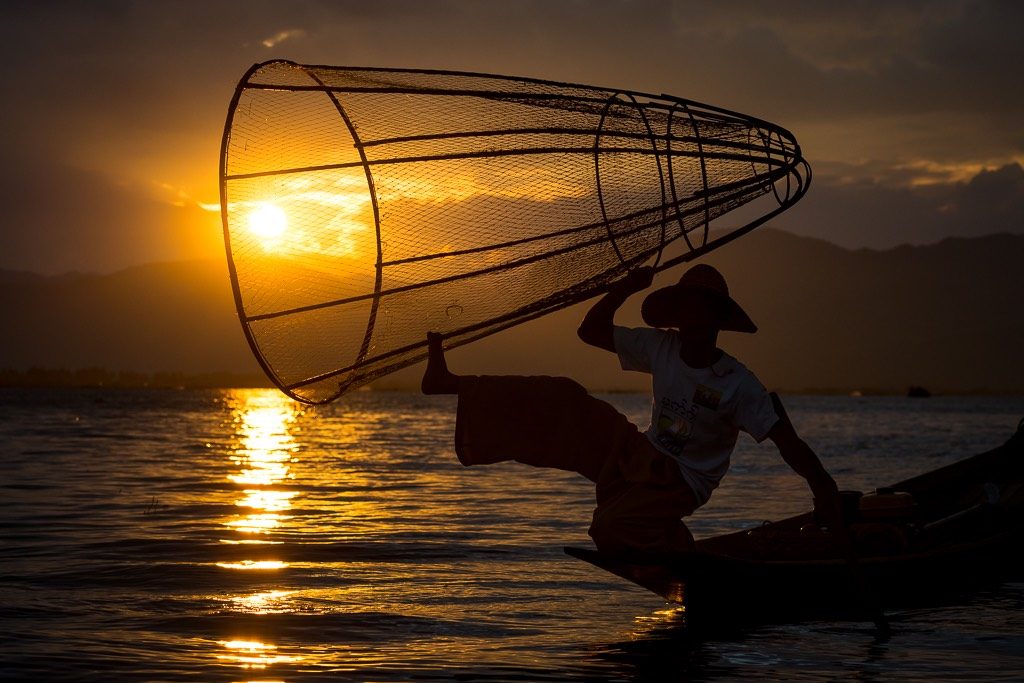
When not fishing, these men display there balance and dexterity on the edge of there boats. They are the Intha fishermen of Inle Lake in Shan State. Here he demonstrates the unusual technique for catching fish in the shallow water under a backdrop of early evening. During the dry season, the average water depth is only 7 feet deep.

Although the images of the ancient sun-drenched pagodas and temples of Bagan stand out in our mind, it’s important to remember many of these sites are still used for worship. Among the tourists are faithful pilgrims from Myanmar and neighboring Thailand. 90% of the 56 million citizens of Myanmar practice Buddhism.

Welcome to Yangon. The mornings here are bustling. Walking through the market streets is a great way to see the daily grind of life in Myanmar’s biggest city. As a foreigner in a strange land, we normally stand out. But at the morning market, everyone is too busy to notice the outsider. There are people with goods balanced on their heads, monks collecting alms, shoppers out to buy their daily groceries, and of course, vendors selling fish, meat, and vegetables, and more. There are also a few bicycle rickshaws transporting goods, weaving through the crowd. Keep going with the flow, don’t stop in traffic, and you’ll blend right in.
Read why Myanmar is my favorite country in southeast Asia.
**These photos and more will be displayed at Steamdot Coffee located at 600 E Northern Lights Blvd Suite 121, Anchorage, AK 99503 through the end of April 2018.
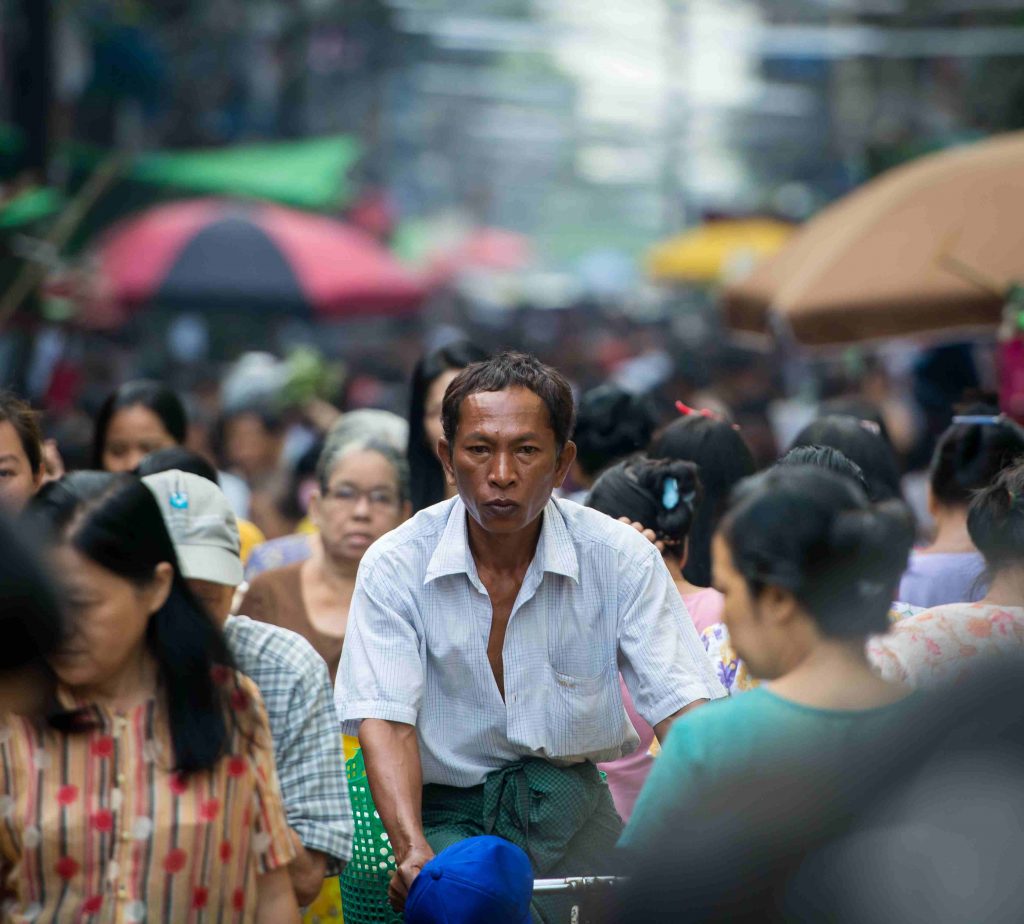
Wow, these are striking photos of Myanmar! Love them all but the fisherman’s silhouette is my favorite.
Such a helpful guide. It’s really very wonderful destination to visit! stunning photos you shared of that beautiful place. Thank you so much for sharing this beautiful post! Loved your post!
Great photos of Myanmar! Love seeing all the pictures of all the places you have been to.
Just found this wonderful piece after reading the Camino Real writeup .
These shots are money
What are you Shooting with?